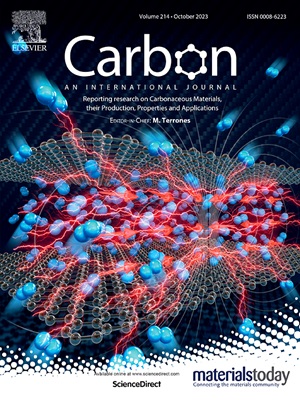Self-healable graphene-cellulose nanofibril composite with strain/humidity responsivity for wearable respiratory monitoring
IF 10.5
2区 材料科学
Q1 CHEMISTRY, PHYSICAL
引用次数: 0
Abstract
Respiratory monitoring has evolved into a critical non-invasive diagnostic tool for managing chronic respiratory pathologies. Despite the progress in the design of strain and humidity sensors for the acquisition of the respiratory patterns, the current systems suffer from significant functional redundancy in the detection of airflow dynamics and humidity oscillations during ventilation cycles, which renders a limited diagnostic specificity in respiratory monitoring. Herein, we developed a strain/humidity bimodal sensor based on a graphene-cellulose nanofibril (graphene-CNF) composite film. The sensor demonstrates superior strain sensing (GF = ∼380 within 0 %–20 % strain) and humidity sensing (0.58 RH-1 within 5 %–90 % RH) performance, as well as unique moisture-triggered self-healing properties (with a healing efficiency of 47.3 % and healing time of 40 s). The multimodal functionality enables versatile applications spanning skin-attachable physiological sensing, environmental monitoring, and proximity-responsive human-machine interfaces. Specifically for respiratory monitoring, the sensor achieves concurrent acquisition of ventilatory waveforms and the hydration status of the exhaled gas, which facilitates the systemic physiological assessment. The as-developed system not only makes substantial optimization in respiratory monitoring mechanism, but also shows great potential in wearable diagnostics, environmental monitoring, and smart interactive devices.
具有应变/湿度响应的可自修复石墨烯-纤维素纳米纤维复合材料用于可穿戴呼吸监测
呼吸监测已经发展成为一种重要的非侵入性诊断工具,用于管理慢性呼吸疾病。尽管用于获取呼吸模式的应变和湿度传感器的设计取得了进展,但目前的系统在检测通风周期中的气流动力学和湿度振荡方面存在显着的功能冗余,这使得呼吸监测的诊断特异性有限。在此,我们开发了一种基于石墨烯-纤维素纳米纤维(石墨烯- cnf)复合薄膜的应变/湿度双峰传感器。该传感器具有优异的应变传感性能(在0% - 20%应变范围内GF = ~ 380)和湿度传感性能(在5% - 90% RH范围内GF = 0.58 RH-1),以及独特的湿度触发自修复性能(愈合效率为47.3%,愈合时间为40 s)。多模态功能支持多种应用,包括皮肤附着的生理传感、环境监测和接近响应的人机界面。针对呼吸监测,传感器实现了通气波形和呼出气体水合状态的同步采集,便于进行全身生理评估。该系统不仅对呼吸监测机制进行了实质性的优化,而且在可穿戴诊断、环境监测、智能交互设备等方面也显示出巨大的潜力。
本文章由计算机程序翻译,如有差异,请以英文原文为准。
求助全文
约1分钟内获得全文
求助全文
来源期刊

Carbon
工程技术-材料科学:综合
CiteScore
20.80
自引率
7.30%
发文量
0
审稿时长
23 days
期刊介绍:
The journal Carbon is an international multidisciplinary forum for communicating scientific advances in the field of carbon materials. It reports new findings related to the formation, structure, properties, behaviors, and technological applications of carbons. Carbons are a broad class of ordered or disordered solid phases composed primarily of elemental carbon, including but not limited to carbon black, carbon fibers and filaments, carbon nanotubes, diamond and diamond-like carbon, fullerenes, glassy carbon, graphite, graphene, graphene-oxide, porous carbons, pyrolytic carbon, and other sp2 and non-sp2 hybridized carbon systems. Carbon is the companion title to the open access journal Carbon Trends. Relevant application areas for carbon materials include biology and medicine, catalysis, electronic, optoelectronic, spintronic, high-frequency, and photonic devices, energy storage and conversion systems, environmental applications and water treatment, smart materials and systems, and structural and thermal applications.
 求助内容:
求助内容: 应助结果提醒方式:
应助结果提醒方式:


